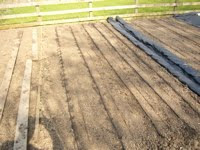Do root vegetables grow better with irrigation?A trial to find out was started on April 9th 2010.
The trialThere is a watered plot and an unwatered plot. Each comprises: -
- 6m row of beetroot, variety Cylindra.
- 2 x 6m rows of carrot, variety Chanteney Red Core.
- 2 x 6m rows of parsnips, variety Albion.
The watered plot will be irrigated using a
WaterWand Heliomatic 130, feeding seep hose laid along the rows. One row will be connected to the pump at a time, with the delivery tube being moved daily so that the rows are watered in rotation.
The plot
The vegetable patch has been newly made in the corner of a field which has been down to grass for about 5 years. This has not been grazed, but mowed by tractor several times a year so the soil has been seriously compacted as the veg garden is where the tractor turned at the field end. The compaction was so bad that rainwater just puddled on top without soaking in.
In December the plot was hand dug using the traditional double digging technique where the soil is dug to one spit deep with a

spade and the soil beneath is then broken up with a fork. This breaks up the compacted soil to allow drainage and aeration.
Although the soil is fairly heavy with plenty of clay, the heavy frosts

through January and February have done a good job of breaking it down so that making a seedbed was relatively easy. I have taken care not to compact the soil, using decking boards to spread my weight when I need to go on to it.
Sowing
The decking board also came in handy as a guide to making a straight seed drill, using a hand hoe to scrape the soil out (picture left). Beetroot seeds were sown individually about every 5cm along the row. Carrots were sprinkled thinly into the drill. The hand hoe was then used again to lightly cover the seeds which were then watered in with a watering can to settle the soils around the seeds and accelerate the onset of germination.
The parsnips were treated slightly differently - a broom handle was used to make a small hole about 2cm deep every 15cm along the row. 3 or 4 seeds were sown in each hole which will be reduced to one plant later on by thinning. These too were covered over and watered in.
Irrigation
8mm diameter seep hose is used with the WaterWand. The larger sizes you often see apply water far too quickly and will not work with the pump.

A stop end and stake were fitted to the hose as shown, which is staked down at one end of the row. The hose was pulled straight along the seed row and staked about every 2m. It was cut to row length and a barbed connector pushed in. The end of the seep hose was staked so that the connector looks up as in the picture. This is repeated for each row.


Protection
Very often with parsnips and carrots there will be gaps in the rows and sometimes no apparent germination at all. Make sure the seed you use is fresh, parsnips in particular will not grow from old seed, but all seeds become less viable over time. Equally important is slug and snail control. I apply a sprinkling of slug pellets before germination, while there is nothing else to eat, to clear the populations before the seedlings emerge. Parsnip seedlings are slugs favourite food and they can eat your seedlings before you even know they have germinated. Your crop is likely to be devastated without protection. It is important to keep birds away to stop them eating the pellets. Horticultural fleece is a great way to do this as it also keeps warmth in, to accelerate growth and keeps carrot root fly out, which can become a problem later on.
Watering
The WaterWand is mounted in a sunny position. It draws rainwater from a water butt. In this situation it will have a "wanderlead" delivery tube attached to the outlet. This is long enough to reach any of the seep hoses. The WaterWand is turned to its maximum setting and the "wanderlead" is connected to one of the seep hoses as shown left. Each day it is moved to the next so that all rows get watered on a regular cycle.
It is very important for the soil around germinating seeds to be kept moist, it provides the water essential for growth and keeps the soil soft enough for the tender young seedlings to push through. It also softens the seed coat allowing the seedlings to shed them more easily.
Where soil fertility is poor, soluble fertiliser can be added to the water source to encourage growth. It is important to remember than dilution rates for soluble fertilisers sometimes allow for clear water irrigations between applications. Using quarter strength is usually about right.
The WaterWand will irrigate every 3 hours during the day. The water is applied very slowly so it has time to soak in, but application continues for a long time so sufficient water is applied. The pump applies more water when it is sunny and your plants need it most.
Follow this blog - if you are interested to know how this trial progresses sign up as a follower now.
































